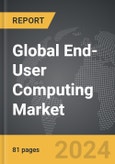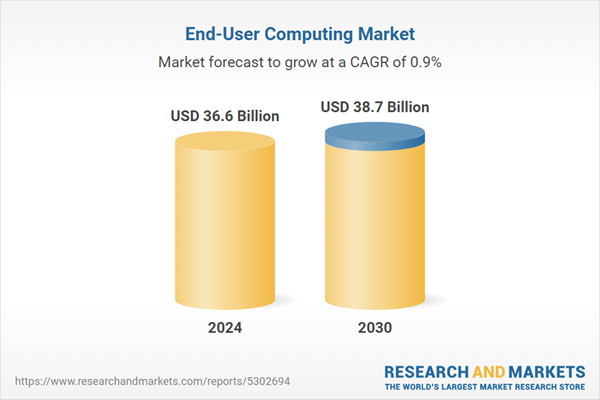Global End-User Computing (EUC) Market - Key Trends & Drivers Summarized
Why Is End-User Computing Essential in Modern Workplaces?
End-User Computing (EUC) refers to technologies and processes that empower employees to access, manage, and utilize data and applications from any device, location, or network, thereby enhancing flexibility, productivity, and user autonomy. EUC solutions include virtual desktop infrastructure (VDI), application virtualization, desktop-as-a-service (DaaS), mobile device management (MDM), and bring-your-own-device (BYOD) policies, all of which support a more agile and responsive IT environment. With the rise of remote work and hybrid work models, EUC has become essential for organizations to enable secure and seamless access to business applications and data, regardless of where employees are working.EUC solutions provide organizations with centralized control over applications and data, simplifying IT management while offering users the flexibility to work from various devices and locations. This centralized approach improves security, as IT teams can enforce policies, monitor usage, and manage updates remotely. In a fast-paced business environment, EUC enhances the digital workplace by allowing end-users to access critical resources in real time, supporting collaboration, productivity, and employee satisfaction. As digital transformation continues, EUC is fundamental in supporting the modern workforce's demands for flexibility and convenience.
How Are Technological Advancements Shaping the End-User Computing Market?
Technological advancements are expanding the capabilities and security of End-User Computing solutions, making them more adaptable to various business needs. Cloud computing, for example, has revolutionized EUC through the growth of Desktop-as-a-Service (DaaS) and virtual desktop infrastructure (VDI) solutions, which allow businesses to deliver secure, scalable desktops and applications directly from the cloud. This technology enables IT teams to deploy virtual desktops on demand, providing employees with a seamless experience while reducing the need for on-premises hardware.Artificial intelligence (AI) and machine learning (ML) are also shaping EUC by enabling predictive maintenance, user behavior analysis, and real-time threat detection. AI-powered EUC solutions can proactively identify potential issues before they impact users, enhancing performance and security. Additionally, advancements in identity and access management (IAM) solutions, such as multifactor authentication (MFA) and single sign-on (SSO), are improving user experience while strengthening security. These innovations ensure that users can access their work environment securely, wherever they are. Together, these technological advancements make EUC more secure, flexible, and efficient, empowering organizations to scale and adapt quickly to changing workforce needs.
What Are the Key Applications of End-User Computing?
End-User Computing is widely applied across industries to support remote work, streamline IT management, and enhance workforce productivity. In the financial sector, EUC solutions support secure data access and compliance with regulatory requirements, enabling employees to access sensitive financial information and applications securely from any location. In healthcare, EUC solutions provide clinicians with secure, remote access to patient data and electronic health records (EHRs), which is essential for telemedicine and remote patient monitoring. EUC also supports healthcare providers by centralizing data management, improving patient data security, and facilitating real-time information sharing across facilities.In education, EUC allows students, faculty, and staff to access learning platforms and academic resources remotely, which is critical for supporting hybrid and remote learning models. Virtual desktops and DaaS solutions are widely used in schools and universities to offer consistent access to educational software and tools across devices. In the manufacturing industry, EUC is used to manage field devices and applications, ensuring that on-site workers have the tools and data they need to work efficiently. These applications highlight EUC's versatility in enabling secure, scalable, and flexible computing environments that meet the specific needs of each industry.
What Is Driving Growth in the End-User Computing Market?
The growth in the End-User Computing market is driven by the rise of remote and hybrid work, increasing focus on IT security and compliance, technological advancements, and the demand for digital transformation. The shift to remote work, accelerated by the COVID-19 pandemic, has led organizations to adopt EUC solutions to enable secure and efficient work from any location. As hybrid work becomes more permanent, companies are increasingly investing in EUC to ensure that employees have the flexibility to work productively from various devices and environments. The rising emphasis on IT security and regulatory compliance is also propelling EUC adoption, as centralized EUC solutions make it easier to enforce data security policies and maintain control over sensitive data.Technological advancements in cloud computing, AI, and identity management are supporting market growth by enabling more flexible, cost-effective, and secure EUC solutions. The demand for digital transformation, as companies look to modernize their infrastructure and improve operational agility, is further driving EUC adoption, particularly in industries where secure and rapid data access is critical to maintaining business continuity. Together, these factors - remote and hybrid work trends, IT security requirements, technological progress, and digital transformation - are driving strong growth in the EUC market, establishing it as a cornerstone of the modern digital workplace.
Report Scope
The report analyzes the End-User Computing market, presented in terms of market value (US$ Thousand). The analysis covers the key segments and geographic regions outlined below.- Segments: Component (Solutions, Services); Vertical (IT & Telecom, BFSI, Education, Healthcare, Retail, Government, Other Verticals).
- Geographic Regions/Countries:World; United States; Canada; Japan; China; Europe (France; Germany; Italy; United Kingdom; Spain; Russia; and Rest of Europe); Asia-Pacific (Australia; India; South Korea; and Rest of Asia-Pacific); Latin America (Argentina; Brazil; Mexico; and Rest of Latin America); Middle East (Iran; Israel; Saudi Arabia; United Arab Emirates; and Rest of Middle East); and Africa.
Key Insights:
- Market Growth: Understand the significant growth trajectory of the Component Solutions segment, which is expected to reach US$27.5 Billion by 2030 with a CAGR of a 1.3%. The Component Services segment is also set to grow at 0% CAGR over the analysis period.
- Regional Analysis: Gain insights into the U.S. market, valued at $9.6 Billion in 2024, and China, forecasted to grow at an impressive 4.2% CAGR to reach $8.8 Billion by 2030. Discover growth trends in other key regions, including Japan, Canada, Germany, and the Asia-Pacific.
Why You Should Buy This Report:
- Detailed Market Analysis: Access a thorough analysis of the Global End-User Computing Market, covering all major geographic regions and market segments.
- Competitive Insights: Get an overview of the competitive landscape, including the market presence of major players across different geographies.
- Future Trends and Drivers: Understand the key trends and drivers shaping the future of the Global End-User Computing Market.
- Actionable Insights: Benefit from actionable insights that can help you identify new revenue opportunities and make strategic business decisions.
Key Questions Answered:
- How is the Global End-User Computing Market expected to evolve by 2030?
- What are the main drivers and restraints affecting the market?
- Which market segments will grow the most over the forecast period?
- How will market shares for different regions and segments change by 2030?
- Who are the leading players in the market, and what are their prospects?
Report Features:
- Comprehensive Market Data: Independent analysis of annual sales and market forecasts in US$ Million from 2024 to 2030.
- In-Depth Regional Analysis: Detailed insights into key markets, including the U.S., China, Japan, Canada, Europe, Asia-Pacific, Latin America, Middle East, and Africa.
- Company Profiles: Coverage of players such as Connection, Coreio, CSS Corp, Data Integrity Inc., Emerio and more.
- Complimentary Updates: Receive free report updates for one year to keep you informed of the latest market developments.
Some of the 18 companies featured in this End-User Computing market report include:
- Connection
- Coreio
- CSS Corp
- Data Integrity Inc.
- Emerio
- EMTEC
- Focus Technology Solutions
- Fortem Information Technology
- Fujitsu
- Genpact
- HCL Infosystems
- Hitachi Systems Micro Clinic
- IDS
- Igel
- Infosys
- Mindtree
- Netapp
- Nucleus Software
- Patriot Technologies
- Serole Technologies
- Sita
- Smp-Corp
- Synapse 360
- Tech Mahindra
- The Ergonomic Group
This edition integrates the latest global trade and economic shifts into comprehensive market analysis. Key updates include:
- Tariff and Trade Impact: Insights into global tariff negotiations across 180+ countries, with analysis of supply chain turbulence, sourcing disruptions, and geographic realignment. Special focus on 2025 as a pivotal year for trade tensions, including updated perspectives on the Trump-era tariffs.
- Adjusted Forecasts and Analytics: Revised global and regional market forecasts through 2030, incorporating tariff effects, economic uncertainty, and structural changes in globalization. Includes historical analysis from 2015 to 2023.
- Strategic Market Dynamics: Evaluation of revised market prospects, regional outlooks, and key economic indicators such as population and urbanization trends.
- Innovation & Technology Trends: Latest developments in product and process innovation, emerging technologies, and key industry drivers shaping the competitive landscape.
- Competitive Intelligence: Updated global market share estimates for 2025, competitive positioning of major players (Strong/Active/Niche/Trivial), and refined focus on leading global brands and core players.
- Expert Insight & Commentary: Strategic analysis from economists, trade experts, and domain specialists to contextualize market shifts and identify emerging opportunities.
Table of Contents
Companies Mentioned (Partial List)
A selection of companies mentioned in this report includes, but is not limited to:
- Connection
- Coreio
- CSS Corp
- Data Integrity Inc.
- Emerio
- EMTEC
- Focus Technology Solutions
- Fortem Information Technology
- Fujitsu
- Genpact
- HCL Infosystems
- Hitachi Systems Micro Clinic
- IDS
- Igel
- Infosys
- Mindtree
- Netapp
- Nucleus Software
- Patriot Technologies
- Serole Technologies
- Sita
- Smp-Corp
- Synapse 360
- Tech Mahindra
- The Ergonomic Group
Table Information
| Report Attribute | Details |
|---|---|
| No. of Pages | 264 |
| Published | December 2025 |
| Forecast Period | 2024 - 2030 |
| Estimated Market Value ( USD | $ 36.6 Billion |
| Forecasted Market Value ( USD | $ 38.7 Billion |
| Compound Annual Growth Rate | 0.9% |
| Regions Covered | Global |









